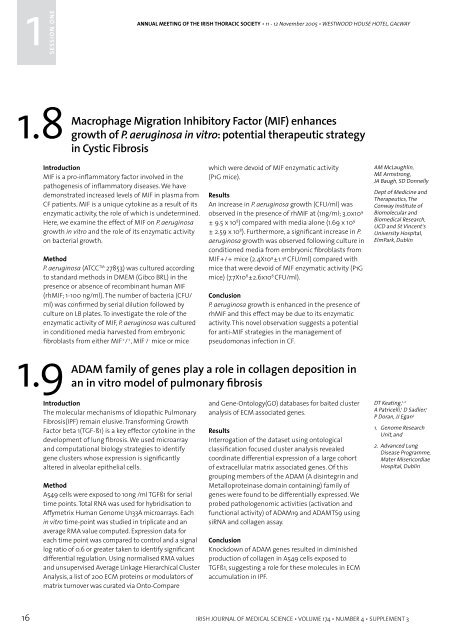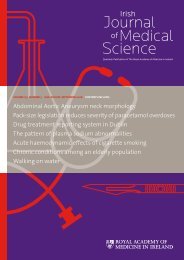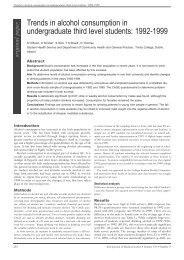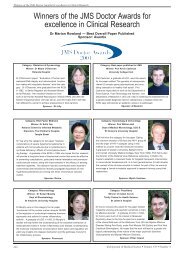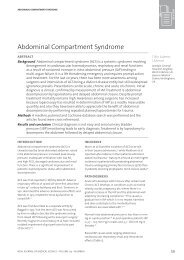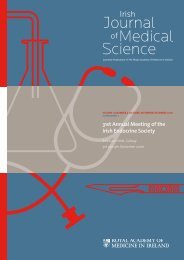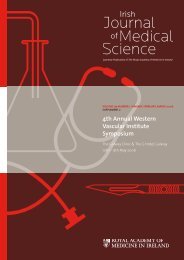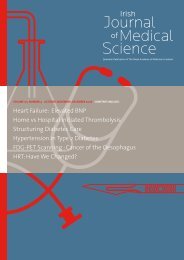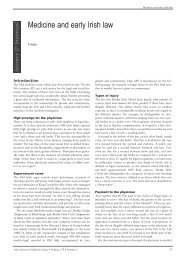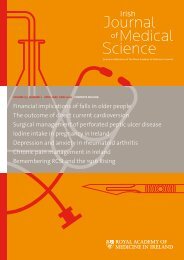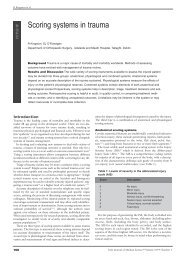Annual General Meeting of the Irish Thoracic Society - IJMS | Irish ...
Annual General Meeting of the Irish Thoracic Society - IJMS | Irish ...
Annual General Meeting of the Irish Thoracic Society - IJMS | Irish ...
Create successful ePaper yourself
Turn your PDF publications into a flip-book with our unique Google optimized e-Paper software.
1<br />
SESSION ONE<br />
1<br />
ANNUAL MEETING OF THE IRISH THORACIC SOCIETY • 11 - 12 November 2005 • WESTWOOD HOUSE HOTEL, GALWAY ANNUAL MEETING OF THE IRISH THORACIC SOCIETY • 11 - 12 November 2005 • WESTWOOD HOUSE HOTEL, GALWAY<br />
SESSION ONE<br />
1.8<br />
1.9<br />
Macrophage Migration Inhibitory Factor (MIF) enhances<br />
growth <strong>of</strong> P. aeruginosa in vitro: potential <strong>the</strong>rapeutic strategy<br />
in Cystic Fibrosis<br />
Introduction<br />
MIF is a pro-inflammatory factor involved in <strong>the</strong><br />
pathogenesis <strong>of</strong> inflammatory diseases. We have<br />
demonstrated increased levels <strong>of</strong> MIF in plasma from<br />
CF patients. MIF is a unique cytokine as a result <strong>of</strong> its<br />
enzymatic activity, <strong>the</strong> role <strong>of</strong> which is undetermined.<br />
Here, we examine <strong>the</strong> effect <strong>of</strong> MIF on P. aeruginosa<br />
growth in vitro and <strong>the</strong> role <strong>of</strong> its enzymatic activity<br />
on bacterial growth.<br />
Method<br />
P. aeruginosa (ATCC TM 27853) was cultured according<br />
to standard methods in DMEM (Gibco BRL) in <strong>the</strong><br />
presence or absence <strong>of</strong> recombinant human MIF<br />
(rhMIF; 1-100 ng/ml). The number <strong>of</strong> bacteria (CFU/<br />
ml) was confirmed by serial dilution followed by<br />
culture on LB plates. To investigate <strong>the</strong> role <strong>of</strong> <strong>the</strong><br />
enzymatic activity <strong>of</strong> MIF, P. aeruginosa was cultured<br />
in conditioned media harvested from embryonic<br />
fibroblasts from ei<strong>the</strong>r MIF + / + , MIF - / - mice or mice<br />
which were devoid <strong>of</strong> MIF enzymatic activity<br />
(P1G mice).<br />
Results<br />
An increase in P. aeruginosa growth (CFU/ml) was<br />
observed in <strong>the</strong> presence <strong>of</strong> rhMIF at (1ng/ml; 3.0x10 9<br />
± 9.5 x 10 8 ) compared with media alone (1.69 x 10 9<br />
± 2.59 x 10 8 ). Fur<strong>the</strong>rmore, a significant increase in P.<br />
aeruginosa growth was observed following culture in<br />
conditioned media from embryonic fibroblasts from<br />
MIF+/+ mice (2.4X10 9 ±1.1 9 CFU/ml) compared with<br />
mice that were devoid <strong>of</strong> MIF enzymatic activity (P1G<br />
mice) (7.7X10 8 ±2.6x10 8 CFU/ml).<br />
Conclusion<br />
P. aeruginosa growth is enhanced in <strong>the</strong> presence <strong>of</strong><br />
rhMIF and this effect may be due to its enzymatic<br />
activity. This novel observation suggests a potential<br />
for anti-MIF strategies in <strong>the</strong> management <strong>of</strong><br />
pseudomonas infection in CF.<br />
ADAM family <strong>of</strong> genes play a role in collagen deposition in<br />
an in vitro model <strong>of</strong> pulmonary fibrosis<br />
AM McLaughlin,<br />
ME Armstrong,<br />
JA Baugh, SD Donnelly<br />
Dept <strong>of</strong> Medicine and<br />
Therapeutics, The<br />
Conway Institute <strong>of</strong><br />
Biomolecular and<br />
Biomedical Research,<br />
UCD and St Vincent’s<br />
University Hospital,<br />
ElmPark, Dublin<br />
1.10<br />
Safety and efficacy <strong>of</strong> prolonged treatment <strong>of</strong> fibrosing<br />
alveolitis in scleroderma with cyclophosphamide<br />
Background<br />
Although cyclophosphamide has been widely<br />
used for <strong>the</strong> treatment <strong>of</strong> fibrosing alveolitis in<br />
Scleroderma, <strong>the</strong>re has been debate over <strong>the</strong> optimal<br />
treatment regime.<br />
Methods<br />
Two groups <strong>of</strong> patients were studied separately at<br />
our centre. The first group (Group A, 14 patients)<br />
were treated with 6 intravenous pulses <strong>of</strong><br />
cyclophosphamide and methylprednisolone at<br />
monthly intervals for 6 months 1 . A second group <strong>of</strong><br />
patients (Group B, 26 patients) were treated with 15<br />
pulses <strong>of</strong> cyclophosphamide and methylprednisolone<br />
at intervals increasing from 3 to 12 weeks.<br />
There was <strong>the</strong> option <strong>of</strong> increasing <strong>the</strong> dose <strong>of</strong><br />
cyclophosphamide if patients deteriorated during<br />
treatment. Both groups were assessed with serial<br />
pulmonary function tests and HRCT thorax.<br />
Time<br />
(months)<br />
Results<br />
Both groups <strong>of</strong> patients had similar characteristics in<br />
terms <strong>of</strong> disease duration and initial lung function.<br />
The effects <strong>of</strong> treatment on pulmonary function<br />
tests are shown below.<br />
Conclusion<br />
Prolonged treatment with cyclophosphamide and<br />
methylprednisolone appears safe and may be more<br />
effective in reducing <strong>the</strong> progression <strong>of</strong> lung fibrosis<br />
in scleroderma.<br />
Reference<br />
1. Griffiths B et al. Systemic sclerosis and<br />
interstitial lung disease: a pilot study to assess<br />
pulse intravenous methylprednisolone and<br />
cyclophosphamide J Rhematol 2002; 29(11):2371.<br />
GROUP A GROUP B GROUP A GROUP B<br />
% Change<br />
in DLCO<br />
p-value<br />
% Change<br />
in DLCO<br />
p-value<br />
% Change<br />
in FVC<br />
p-value<br />
Change in<br />
FVC<br />
p-value<br />
6 -7.4 0.24 0.5 0.75 0 0.66 0 0.70<br />
12 -8.6 0.39 -4.3 0.06 3.3 0.34 0.25 0.20<br />
24 -10 0.04 -6.6 0.14 0.5 0.25 1.2 0.16<br />
*P-values have been calculated by <strong>the</strong> Wilcoxon rank test.<br />
*No patients withdrew from treatment because <strong>of</strong> toxicity from cyclophosphamide and no deaths were recorded.<br />
1.11<br />
MT Henry, 2 S Dass, 1<br />
C Fernandes, 1<br />
B Griffiths, 1 P Emery, 1<br />
1. Dept <strong>of</strong><br />
Rheumatology, and<br />
2. Dept <strong>of</strong> Respiratory<br />
Medicine, Leeds<br />
<strong>General</strong> Infirmary,<br />
Leeds, UK<br />
Introduction<br />
The molecular mechanisms <strong>of</strong> Idiopathic Pulmonary<br />
Fibrosis(IPF) remain elusive. Transforming Growth<br />
Factor beta 1(TGF-ß1) is a key effector cytokine in <strong>the</strong><br />
development <strong>of</strong> lung fibrosis. We used microarray<br />
and computational biology strategies to identify<br />
gene clusters whose expression is significantly<br />
altered in alveolar epi<strong>the</strong>lial cells.<br />
Method<br />
A549 cells were exposed to 10ng /ml TGFß1 for serial<br />
time points. Total RNA was used for hybridisation to<br />
Affymetrix Human Genome U133A microarrays. Each<br />
in vitro time-point was studied in triplicate and an<br />
average RMA value computed. Expression data for<br />
each time point was compared to control and a signal<br />
log ratio <strong>of</strong> 0.6 or greater taken to identify significant<br />
differential regulation. Using normalised RMA values<br />
and unsupervised Average Linkage Hierarchical Cluster<br />
Analysis, a list <strong>of</strong> 200 ECM proteins or modulators <strong>of</strong><br />
matrix turnover was curated via Onto-Compare<br />
and Gene-Ontology(GO) databases for baited cluster<br />
analysis <strong>of</strong> ECM associated genes.<br />
Results<br />
Interrogation <strong>of</strong> <strong>the</strong> dataset using ontological<br />
classification focused cluster analysis revealed<br />
coordinate differential expression <strong>of</strong> a large cohort<br />
<strong>of</strong> extracellular matrix associated genes. Of this<br />
grouping members <strong>of</strong> <strong>the</strong> ADAM (A disintegrin and<br />
Metalloproteinase domain containing) family <strong>of</strong><br />
genes were found to be differentially expressed. We<br />
probed pathologenomic activities (activation and<br />
functional activity) <strong>of</strong> ADAM19 and ADAMTS9 using<br />
siRNA and collagen assay.<br />
Conclusion<br />
Knockdown <strong>of</strong> ADAM genes resulted in diminished<br />
production <strong>of</strong> collagen in A549 cells exposed to<br />
TGFß1, suggesting a role for <strong>the</strong>se molecules in ECM<br />
accumulation in IPF.<br />
DT Keating, 1, 2<br />
A Patricelli, 1 D Sadlier, 1<br />
P Doran, JJ Egan 2<br />
1. Genome Research<br />
Unit, and<br />
2. Advanced Lung<br />
Disease Programme,<br />
Mater Misericordiae<br />
Hospital, Dublin<br />
Efficacy <strong>of</strong> pulmonary rehabilitation in interstitial lung disease<br />
Background<br />
Pulmonary rehabilitation (PRP) is effective in<br />
improving exercise endurance and quality <strong>of</strong> life<br />
(QoL) in COPD. However, data on <strong>the</strong> efficacy <strong>of</strong> PRP in<br />
interstitial lung disease (ILD) is limited .<br />
Methods<br />
35 patients with ILD (mean DLCO 40.3±14.9%pred<br />
, mean age 67.7±10.7) were admitted to PRP; 19<br />
completed <strong>the</strong> 8 weeks programme and 10 were<br />
followed to 1 year. Pulmonary function tests, exercise<br />
endurance and QoL (Chronic Respiratory Disease<br />
- CRDQ, St.George’s Respiratory - SGRQ, Hospital<br />
Anxiety and Depression - HAD) and dyspnoea were<br />
measured at baseline, 8 weeks and 1 year. The sample<br />
studied was subgrouped - group 1 DLCO ≤35%pred.<br />
(n=14), group 2 DLCO >35% pred. (n=17). 4 patients<br />
were unable to perform <strong>the</strong> test.<br />
Results<br />
Overall exercise endurance (treadmill) improved<br />
at 8 weeks (p


